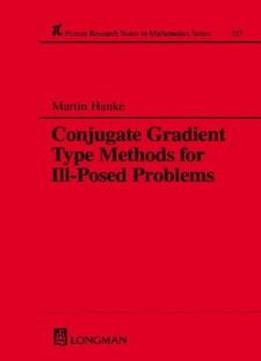
Conjugate Gradient Type Methods For Ill-posed Problems (chapman & Hall/crc Research Notes In Mathematics Series)
by Martin Hanke /
1995 / English / PDF
3 MB Download
The conjugate gradient method is a powerful tool for the iterative
solution of self-adjoint operator equations in Hilbert space.This
volume summarizes and extends the developments of the past decade
concerning the applicability of the conjugate gradient method (and
some of its variants) to ill posed problems and their
regularization. Such problems occur in applications from almost all
natural and technical sciences, including astronomical and
geophysical imaging, signal analysis, computerized tomography,
inverse heat transfer problems, and many more
The conjugate gradient method is a powerful tool for the iterative
solution of self-adjoint operator equations in Hilbert space.This
volume summarizes and extends the developments of the past decade
concerning the applicability of the conjugate gradient method (and
some of its variants) to ill posed problems and their
regularization. Such problems occur in applications from almost all
natural and technical sciences, including astronomical and
geophysical imaging, signal analysis, computerized tomography,
inverse heat transfer problems, and many more
This Research Note presents a unifying analysis of an entire family
of conjugate gradient type methods. Most of the results are as yet
unpublished, or obscured in the Russian literature. Beginning with
the original results by Nemirovskii and others for minimal residual
type methods, equally sharp convergence results are then derived
with a different technique for the classical Hestenes-Stiefel
algorithm. In the final chapter some of these results are extended
to selfadjoint indefinite operator equations.
This Research Note presents a unifying analysis of an entire family
of conjugate gradient type methods. Most of the results are as yet
unpublished, or obscured in the Russian literature. Beginning with
the original results by Nemirovskii and others for minimal residual
type methods, equally sharp convergence results are then derived
with a different technique for the classical Hestenes-Stiefel
algorithm. In the final chapter some of these results are extended
to selfadjoint indefinite operator equations.
The main tool for the analysis is the connection of conjugate
gradient
The main tool for the analysis is the connection of conjugate
gradient
type methods to real orthogonal polynomials, and elementary
type methods to real orthogonal polynomials, and elementary
properties of these polynomials. These prerequisites are provided
in
properties of these polynomials. These prerequisites are provided
in
a first chapter. Applications to image reconstruction and
inverse
a first chapter. Applications to image reconstruction and
inverse
heat transfer problems are pointed out, and exemplarily
numerical
heat transfer problems are pointed out, and exemplarily
numerical
results are shown for these applications.
results are shown for these applications.











